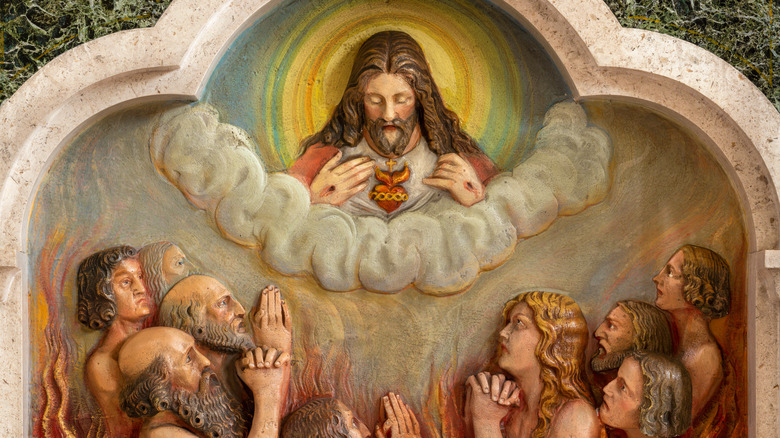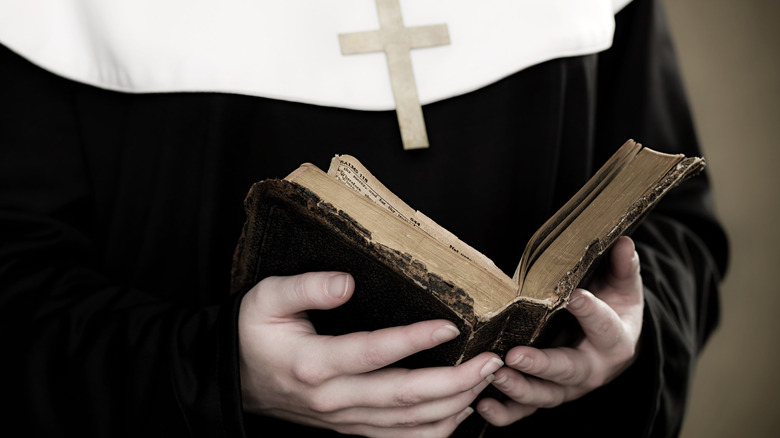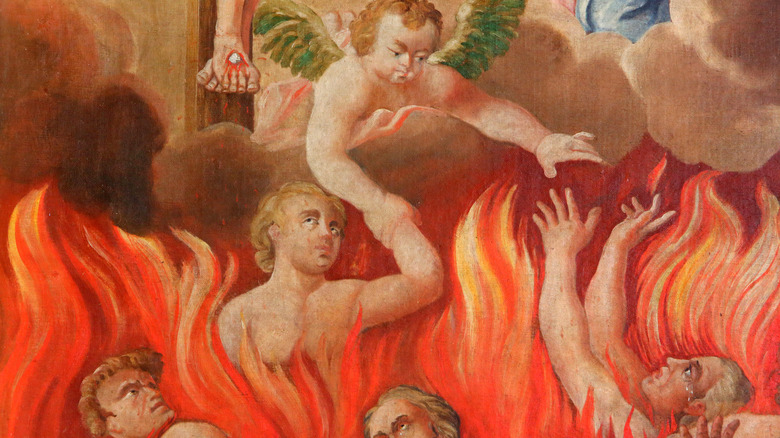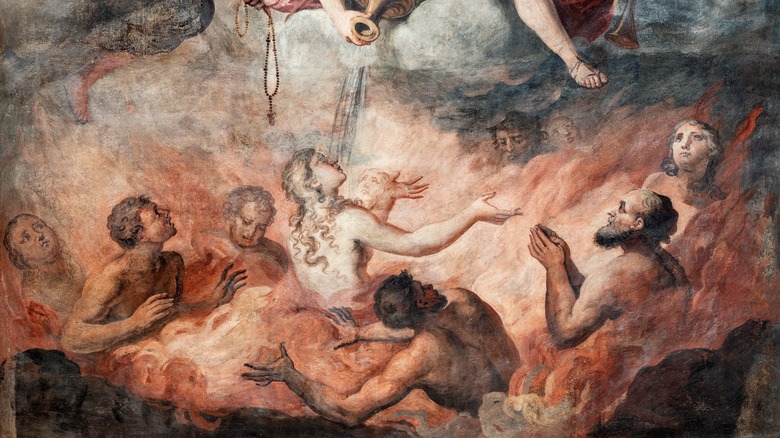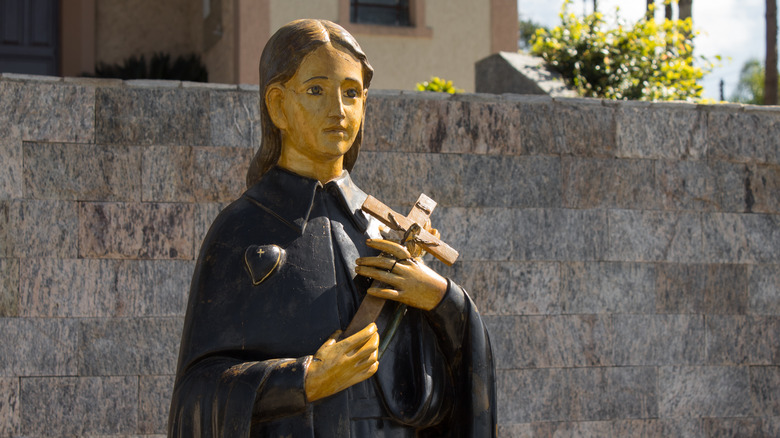What Purgatory Is Like, According To People Who Claim To Have Been There
The "Catechism of the Catholic Church," a work that lays out the institution's doctrine, defines purgatory as "purification, so as to achieve the holiness necessary to enter the joy of heaven." Merriam-Webster describes it as "an intermediate state after death for expiatory purification," pointing to Roman Catholic writings that claim it is a "place or state of punishment" where "the souls of those who die in God's grace may make satisfaction for past sins and so become fit for heaven." Though purgatory is also used nowadays to describe a "place or state of temporary suffering or misery," as the dictionary says, for the purposes of this article, we'll be exploring the spiritual definitions.
The type of sin committed in one's life also affects accounts of purgatory. In Roman Catholic doctrine, venial sins are considered less severe than mortal sins, such as envy, or neglecting prayer. The "Catechism of the Catholic Church" says such transgressions "constitute a moral disorder that is reparable by charity, which it allows to subsist in us." But they are said to leave one increasingly susceptible to committing mortal sins like murder — "sin whose object is grave matter and which is also committed with full knowledge and deliberate consent."
There are many people throughout history who claimed to have experienced purgatory. Though of course none of these accounts can ever truly be verified, they're fascinating nonetheless and even overlap with some of what we know about near-death experiences. Here are some of the most interesting accounts.
A deceased nun speaks
In November 1873, a nun — identified as Sister M. de L.C. to keep her identity secret — allegedly spoke to a soul in purgatory. It was a nun from her covenant, Sister M.G., who had died over two years earlier. Her account is outlined in December 1967's "An Unpublished Manuscript on Purgatory."
"In the great Purgatory there are several stages," the soul allegedly said. "In the lowest and most painful, it is like a temporary hell, and here there are the sinners who have committed terrible crimes during life and whose death surprised them in that state." At this level of apparent mortal sin, she said there are also souls who were "indifferent to God." The next stage is for those who at the time of their death had "venial sins not fully expiated" or mortal sins that were "forgiven but for which they have not made entire satisfaction to the Divine Justice."
Finally, the "Purgatory of desire," also known as "the Threshold," which Sister M.G. allegedly said few people escape. "To avoid it altogether, one must ardently desire Heaven and the vision of God," the soul said. "That is rare. Rarer than people think, because even pious people are afraid of God and have not, therefore, a sufficiently strong desire of going to Heaven."
The idea of levels or stages of purgatory was popularized by the works of Italian poet Dante Alighieri. The Bible itself never explicitly says that purgatory exists, though French historian Jacques Le Goff dated the term "purgatorium" to around 1170. By the time Alighieri's work was finished somewhere around 1308 to 1321, the idea was already enshrined in the doctrine of the Catholic Church, though it said little about what actually took place in the passing process or place.
A near-death experience and a trip to purgatory
In 1985, Father Jose Maniyangat got into a motorcycle accident. He survived, but claims to have "experienced death," and says in this time he was escorted to heaven, hell, and purgatory. On his website, his story is prefaced with a disclaimer that says the Diocese of St. Augustine investigated his claims and "cannot authenticate, endorse, nor approve in any way" its "factual or theological contents." Nevertheless, he continues to tell his tale and has appeared on various podcasts doing just that.
In hell, Maniyangat claims there are seven levels of suffering, each defined by "the number and kinds of mortal sins" its inhabitants committed during their lives. In purgatory, too, he says there are seven stages, but "far less intense than hell and there was neither quarreling nor fighting." "The main suffering of these souls is their separation from God," he wrote on his website, noting that some here did commit mortal sins during their life but "reconciled with God" before they died. "Even though these souls are suffering, they enjoy peace and the knowledge that one day they will see God face to face," he said.
Maniyangat said he spoke to many souls in purgatory, who asked him to pray for them and spread the word to others to do the same. These souls were waiting to enter heaven. His claims have not been well-received by all. One commenter on his "Uniquely Mary" interview appearance suggested his apparent experience conflicts with Christian doctrine. "Purgatory does not exist," they wrote. "There is 0 mention of it in The Bible. Purgatory is a way for people to believe that they can still sin while alive, be put there and then be granted passage to heaven after some time."
'Helpless souls'
In "All for Jesus, Or, The Easy Ways of Divine Love," English theologian Frederick William Faber covers an account of purgatory that came through Sister Francesca. Though she herself never went there, she apparently spoke of a 14-year-old girl who did because she was too young at the time of her death to have "conformed to the will of God." While there, one soul allegedly told her, "Ah men little think in the world how dearly they are going to pay here for faults they hardly note there."
Faber pointed the this account as expressive of the nature of purgatory. "Wrong notions about small faults may thus lead us to neglect the dead, or leave off our prayers too soon, as well as lose a lesson for ourselves," he wrote. "Then, again, both views agree as to the helplessness of the Holy Souls." The term "Holy Souls" refers to those in purgatory, and those that the faithful offer prayers to in life.
An Italian mystic is visited
"The Life of St. Gemma Galgani" offers yet another account of purgatory. The book was written by the Venerable Father Germanus Ruoppolo C.P., the Italian mystic's spiritual director. In it, he describes an account from Galgani — also known as the "Daughter of Passion" — who was canonized as a saint by the Catholic Church in 1940. She claimed to have spoken with a religious sister who died after suffering for a few months.
Her soul allegedly appeared to Galgani "full of sorrow, imploring her help" as she suffered in purgatory. Galgani spent her next days offering "prayers, tears and loving petitions" to God to save the sister. And in her diary from this time, she describes being visited by the soul — in the form of a woman dressed in white. "I thank you so very much for the great concern you have shown me because soon I shall be able to attain my eternal happiness," they allegedly said.
The Daughter of Passion claimed that after 16 days she saw Mary, the mother of Jesus in Christianity, and then the sister with her guardian angel and Jesus, the Son of God in the same doctrine. The soul thanked her before departing. "She made sign of bidding me good-bye with her hand, several times, and with Jesus and her Guardian Angel she flew to Heaven," Galgani wrote.
In the years since, some have speculated that Gamma experienced mental health issues. The Guardian claims she was "given to displays of flamboyant suffering, to public and extreme fasting and self-denial and the exhibition of torn and bleeding flesh." She also claimed to have experienced stigmata — marks or pains that align with Jesus' crucifixion wounds. In "Occult and Supernatural Phenomena," psychologist Donovan Rawcliffe called them the "self-inflicted wounds of a major hysteric."
Near-death experiences and purgatory
A study published in Missouri Medicine outlines the various types of near-death experiences (NDEs) that have been reported, and it's not hard to see similarities to purgatory. One type describes encounters with a "vast emptiness," defined by "aloneness, isolation, sometimes annihilation." A woman in childbirth described "pure hell." "I was screaming, but no sound was going forth," she said. "I realized that this was eternity," she later added, "this was what forever was going to be ... I felt the aloneness, the emptiness of space, the vastness of the universe, except for me, a mere ball of light, screaming."
Some are never the same after their NDEs, for better or worse. One person described a "horror in [their] mind" that stayed with them all 29 years after it happened, and many describe the experiences as making them feel at a distance from religion. "I was filled with a sense of absolute terror and of being past the help of anyone, even God," one person recalled. "I looked around me. Consciously searching for ... God or some other angelic creature, but I was alone," said another. Others begin to believe in some sort of life after death and fear that someday they will return to these purgatories and hells. "I don't believe in a hell, but it was such a strong experience, there is always that underlying uncertainty and trouble and fear," one person said.
Magis Center says that NDEs and accounts of purgatory are not incompatible. At least, in the sense that they can both suggest the way we live our lives in the present is important for whatever comes after. The non-profit educational organization aims to explore and promote the "intersection of science, reason, and faith."
